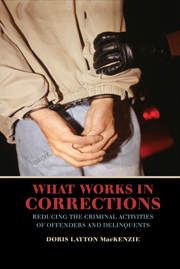Book contents
- Frontmatter
- Contents
- Acknowledgments
- PART ONE STRATEGIES FOR REDUCING CRIME
- PART TWO THE EFFECTIVENESS OF REHABILITATION PROGRAMS
- 5 Academic Education and Life Skills Programs
- 6 Vocational Education and Work Programs
- 7 Cognitive Behavioral Therapy Programs
- PART THREE TARGETING SPECIFIC TYPES OF OFFENDERS
- PART FOUR MANAGEMENT AND TREATMENT OF SUBSTANCE ABUSERS
- PART FIVE CONTROL, DISCIPLINE, AND PUNISHMENT
- PART SIX CONCLUSIONS
- References
- Index
- CAMBRIDGE STUDIES IN CRIMINOLOGY
7 - Cognitive Behavioral Therapy Programs
Published online by Cambridge University Press: 27 July 2009
- Frontmatter
- Contents
- Acknowledgments
- PART ONE STRATEGIES FOR REDUCING CRIME
- PART TWO THE EFFECTIVENESS OF REHABILITATION PROGRAMS
- 5 Academic Education and Life Skills Programs
- 6 Vocational Education and Work Programs
- 7 Cognitive Behavioral Therapy Programs
- PART THREE TARGETING SPECIFIC TYPES OF OFFENDERS
- PART FOUR MANAGEMENT AND TREATMENT OF SUBSTANCE ABUSERS
- PART FIVE CONTROL, DISCIPLINE, AND PUNISHMENT
- PART SIX CONCLUSIONS
- References
- Index
- CAMBRIDGE STUDIES IN CRIMINOLOGY
Summary
INTRODUCTION
Cognitive-behavioral treatments have become the dominant paradigm in clinical psychology (Dobson & Khatri, 2000). Based on cognitive-behavioral theory, these therapies represent a broad category of interventions that focus on human change through demonstrated behavioral outcomes. Changes in behavior are achieved through changes in the way an individual perceives, reflects, and thinks about their life (Dobson & Khatri, 2000). Theoretically, cognitive-behaviorism assumes that cognitions affect behavior, people can monitor and alter their cognitive activity, and changes in cognitions will lead to changes in behavior (Dobson & Craig, 1996). Therapy emphasizes the connection between cognitions and behavior. Dysfunctional behaviors are altered through changes in attitudes, beliefs, and thought processes (Porporino, Fabiano, & Robinson, 1991). In therapy, clients are made aware of their maladaptive thought processes, and they are encouraged to alter the way they think. These alterations in thinking are expected to alter the maladaptive behaviors being targeted by therapy.
The positive effects of cognitive-behavioral approaches to treatment have been a consistent theme in reviews of rehabilitation research (Cullen & Gendreau, 1989; Gendreau & Ross, 1987; Husband & Platt, 1993, Lipsy, 1992; Losel, 1995a). For example, in a meta-analysis of adult and juvenile correctional treatment programs, Andrews, Zinger, Hoge, Bonta, Gendreau, and Cullen (1990) identified cognitive-behavioral methods of therapy as one of the most critical aspects of effective correctional treatment.
- Type
- Chapter
- Information
- What Works in CorrectionsReducing the Criminal Activities of Offenders and Deliquents, pp. 112 - 134Publisher: Cambridge University PressPrint publication year: 2006



